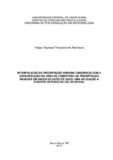| dc.creator | Mendoza, Felipe Raphael Theodorovitz | |
| dc.date.accessioned | 2021-08-09T18:08:47Z | |
| dc.date.available | 2021-08-09T18:08:47Z | |
| dc.date.issued | 2017-03-15 | |
| dc.identifier.uri | http://repositorio.ufsm.br/handle/1/21848 | |
| dc.description.abstract | The characterization of the space-time occurrence of precipitation is fundamental for ade-
quate quantification of the regional water availability, in the form of flow in the rivers, of the
water demand by the natural and agricultural ecosystems, in the form of evapotranspira-
tion and characterization of severe events, such as droughts and floods. The adequate
quantification of these events is directly related to the quality of precipitation measurement,
through the terrestrial hydrological cycle. In this research are selected events occurred
between the years of 2011 and 2016 when there is a report of natural disasters by the Civil
Defense of Rio Grande do Sul. A methodology is proposed that simulates the intensity and
specifies the area of coverage of the precipitation. For this, the Inverse Distance Weigh-
ted (IDW) interpolation method is combined with optimization of its parameters p and dx
through cross-validation and data from the GOES12 satellite in the infrared channel (IDW)
.LTBh). For that, we used data from the National Institute of Meteorology (INMET), National
Water Agency (ANA) and Civil Defense-RS (DC-RS) that, when combined, define the study
events . Methodologies for defining brightness temperature thresholds that determine the
rainfall and non-rainfall regions (Temperature Range of Time Brightness (LTBh)), Tempe-
rature Threshold (LTBev)) and Optimized Brightness Temperature Limit (LTBotim)). From
this, the IDW optimized method is applied by cross-validation within each region defined
by the thresholds (masks). The results of the masks with different brightness temperature
thresholds and cross validation were evaluated with CSI, MAE and NRMSE and with two
other methods of precipitation estimation through remote sensing: GSMAP and CMORPH.
The result of the parameters for the MAE showed better results for the LTBh. However, it is
recommended the test with several statistical indices for cross-validation, since the statisti-
cal indices were sensitive for each case of severe event. The LTBh and LTBotim methods
were similar for the qualitative evaluation of the precipitation, but in the quantitative evalua-
tion (PC and CSI), LTBh obtained better results. | eng |
| dc.language | por | por |
| dc.publisher | Universidade Federal de Santa Maria | por |
| dc.rights | Attribution-NonCommercial-NoDerivatives 4.0 International | * |
| dc.rights.uri | http://creativecommons.org/licenses/by-nc-nd/4.0/ | * |
| dc.subject | Sul do Brasil | por |
| dc.subject | Interpolação | por |
| dc.subject | IDW | por |
| dc.subject | GOES12 | por |
| dc.subject | GSMAP | por |
| dc.subject | CMORPH | por |
| dc.subject | Southern Brazil | eng |
| dc.subject | Interpolation | eng |
| dc.title | Interpolação da precipitação horária observada com a especificação da área de cobertura da precipitação baseada em dados do satélite GOES: uma aplicação a eventos severos no sul do Brasil | por |
| dc.title.alternative | Interpolation of the observed hourly precipitation with the specification of the rainfall coverage area based on GOES satellite data: an application to severe events in southern Brazil | eng |
| dc.type | Dissertação | por |
| dc.description.resumo | A caracterização da ocorrência espaço-temporal da precipitação é fundamental para quan-
tificação adequada da disponibilidade hídrica regional, na forma de vazão nos rios, da de-
manda hídrica pelos ecossistemas naturais e agrícolas, na forma de evapotranspiração e
caracterização de eventos severos, como secas e enchentes. A quantificação adequada
destes eventos está diretamente relacionada à qualidade da medida da precipitação, atra-
vés do ciclo hidrológico terrestre. Nesta pesquisa são selecionados eventos ocorridos entre
os anos de 2011 e 2016 quando existe reporte de desastres naturais pela Defesa Civil do
Rio Grande do Sul. É proposta uma metodologia que simule a intensidade e especifique a
área de cobertura da precipitação. Para isso, combina-se o método de interpolação Ponde-
rada pelo Inverso da Distância (IDW) com otimização de seus parâmetros p e dx através de
validação cruzada e dados do satélite GOES12 no canal infravermelho-4km (IDW.LTBh).
Para isso foram utilizados dados no Instituto Nacional de Meteorologia (INMET), Agência
Nacional das Águas (ANA) e Defesa Civil-RS (DC-RS) que combinados definem os even-
tos de estudo. A partir dos dados horários do INMET e diários da ANA, foram analisadas
metodologias para definição de limiares de temperatura de brilho que determinam as re-
giões de chuva e não chuva (Limiar de Temperatura de Brilho Horário (LTBh), Limiar de
Temperatura de Brilho por Evento (LTBev) e Limiar de Temperatura de Brilho Otimizado
(LTBotim)). A partir disso, é aplicado o método IDW otimizado por validação cruzada den-
tro de cada região definida pelos limiares (máscaras). Os resultados das máscaras com
os diferentes limiares de temperatura de brilho e da validação cruzada foram avaliados
com o CSI, MAE eNRMSE e com outras duas metodologias de estimativa de precipitação
através de sensoriamento remoto: o GSMAP e CMORPH. O resultado dos parâmetros
para o MAE mostraram-se com melhores resultados para o LTBh. Porém, recomenda-se
o teste com vários índices estatísticos para a validação cruzada, pois os índices estatísti-
cos mostraram-se sensíveis para cada caso de evento severo. O método LTBh e LTBotim
mostraram-se similares quanto a avaliação qualitativa da precipitação, porém, na avaliação
quantitativa (PC e CSI), o LTBh obteve resultados superiores. | por |
| dc.contributor.advisor1 | Tatsch, Jônatan Dupont | |
| dc.contributor.advisor1Lattes | http://lattes.cnpq.br/2365902346826079 | por |
| dc.contributor.referee1 | Muza, Michel | |
| dc.contributor.referee2 | Anabor, Vagner | |
| dc.creator.Lattes | http://lattes.cnpq.br/4047559603686450 | por |
| dc.publisher.country | Brasil | por |
| dc.publisher.department | Meteorologia | por |
| dc.publisher.initials | UFSM | por |
| dc.publisher.program | Programa de Pós-Graduação em Meteorologia | por |
| dc.subject.cnpq | CNPQ::CIENCIAS EXATAS E DA TERRA::GEOCIENCIAS::METEOROLOGIA | por |
| dc.publisher.unidade | Centro de Ciências Naturais e Exatas | por |



